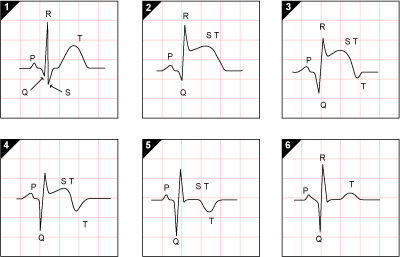Cardiology Teaching Package
A Beginners Guide to Normal Heart Function, Sinus Rhythm & Common Cardiac Arrhythmias
Sequence of Changes in Myocardial Infarction
The ECG sequence below gives you an idea as to how ST Elevation would develop with this process of necrosis.
Image: Sequence of Changes in evolving AMI

Let's work through the sequence in numerical order:
- This picture shows a normal sinus complex. The ST segment is on the iso-electric line. At the onset of pain the ECG would be normal but the ST segment would soon start to change. In this picture, the T wave has grown taller.
- Within an hour the ST segment would be noticeably elevated, indicating the onset on myocardial necrosis. (tissue death). This is the point at which we would be aiming to administer the thrombolytic (clot-busting) drug.
- If thrombolysis is administered, we would be looking for specific changes on the ECG. A 50% reduction in ST segment elevation is a good indicator of success. In this picture, the ST elevation has reduced by more than 50% from picture 2. We would expect to see these changes within 90 minutes of administering thrombolysis. You can also see the T wave invertion is much deeper. This is a good sign of reperfusion. (blood flow returning to the damaged area.)
- 24 hours later, the ST segment may have returned to the iso-electric line. In this picture you can see the ST segment is back on the iso-electric line but the T wave remains inverted. It may stay inverted for days, weeks or months.
- 6. In some cases, after a few months the ECG looks relatively normal. Compare picture 6 with picture 1. They look much the same but for the deep Q wave in picture 6. A deep Q wave is an indicator of myocardial tissue death and will remain on the ECG. A "pathological" Q wave is not "time-specific". It may be there from a previous heart attack and therefore is not part of the criteria for evaluating an Acute Myocardial Infarction.
Acute Coronary Syndrome Is Not A Diagnosis.
It is a collective term for the three conditions discussed and a specific diagnosis should be confirmed once all relevant information has been collected.
